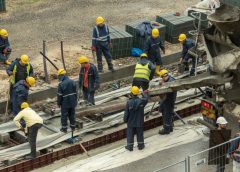Working in the rain poses unique challenges and risks for construction workers. The safety of the workforce should be the top priority under such conditions, necessitating the implementation of specific strategies and safety measures. Wet weather increases the risk of slips, trips, and falls and complicates the handling of equipment and materials.
Let’s look at ways to keep construction workers safe in the rain and minimize potential accidents and injuries.
Wear Proper Gear
Wearing the right gear is crucial when working in the rain. Construction workers should have waterproof jackets, trousers, boots, and gloves to protect them from getting wet. Wet clothing can cause discomfort and slow down work if a worker doesn’t change out of it immediately. Additionally, non-slip footwear is essential to prevent slips and falls on slick surfaces. Hi-vis clothing in the rain can also improve visibility and reduce the risk of accidents involving vehicles and heavy equipment.
Use Slip-Resistant Materials
Incorporating slip-resistant materials in construction sites can significantly reduce the risk of accidents. For better traction, you should install non-slip coatings or grit tape on stairs, walkways, and ramps. Additionally, using mats and grates at entry points can help prevent water from pooling on the floor, reducing the risk of slips and falls.
Give Proper Training
Proper training is vital in keeping construction workers safe in the rain. You should train workers in identifying potential hazards during wet weather and proper techniques for working in slippery conditions. This training includes learning how to handle equipment and materials safely and knowing the proper way to walk on wet surfaces. Regular training sessions should keep workers updated on safety protocols and procedures.
Conduct Site Inspections
Regular site inspections are crucial in identifying potential hazards and ensuring you follow all safety measures. During rainy weather, it’s essential to check for any areas prone to flooding or standing water and any equipment or materials that may pose a risk in wet conditions. You should address identified hazards immediately to prevent accidents.
Implement a Rainy-Weather Policy
A clear rainy-weather policy can help keep construction workers safe. The policy should outline procedures for working in the rain, including when you should stop work to dry off and change clothing and when it’s safe to resume work. It should also include guidelines for handling equipment and materials in wet conditions.
Working under rainy conditions requires careful consideration and adherence to safety protocols to protect construction workers. By doing all these things, construction sites can minimize risks and ensure the safety of their workforce. You must implement these practices regularly to adapt to new safety standards and environmental challenges.




